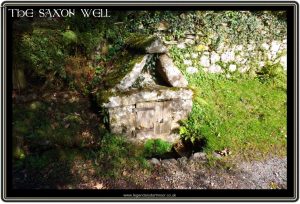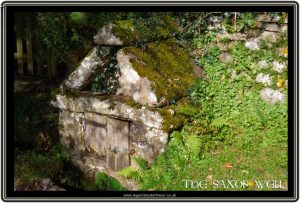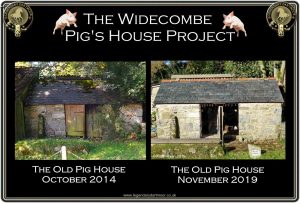
Probably the unsung hero of Widecombe-in-the-Moor is the tiny well located at the edge of the main square. Visitors tend to flock to the church and the shops in search of ‘Uncle Tom’ and can quite easily miss what has been described as the, “most picturesque well in Devon. It is a feature that is hard to date and probably the name, “Saxon Well”, is a bit misleading. The well has also been known as a holy well but there is no connection with any saint although it is said the waters have healing powers for eye problems. The waters however are reputed to have healing qualities, especially for eye complaints. There is also a tradition that the well has never been known to run dry although in times of drought the doors are securely locked. The actual well is fed from a spring in the garden behind and then piped into the small building. Another legend is connected with the great storm of 1638 when the Devil wreaked havoc on the church. The normal version is that Satan stopped off at the Poundsgate Inn for a drink but the Widecombe story has it that he stopped at the Saxon Well for a cup of water. As he gulped the water down his throat a tremendous sizzling noise came from his mouth as if the cool moorland water was turning to steam in his sulphurous gullet.
Since the invention of the motor vehicle the well has taken on the legendary status of a ‘wishing well’, which has probably more to do with attracting tourists than any mythical properties. This can clearly be seen by the two examples of postcards. The oldest one simply portrays the well in all its splendour. Whereas the other postcard depicts a young woman reverently sipping from a cup of the well water and is titled the ‘Widecombe Wishing Well’. It is interesting to see the faggots bundled up beside the well which is a real ‘blast from the past’. I have heard stories about how some of the local children would sometimes go and ‘clean’ the well of any obstructions like leaves, paper, oh, and the odd coin or two.
Whilst visiting the well there is another interesting feature a few yard away. The Widecombe History Group are running a project to restore an old pig house with the help of the Lottery Heritage funded Moor Than Meets The Eye. Not that long ago many households had a pig’s house to fatten one or two pigs in. It was also a good way of using all the household food waste with virtually everything going into the swill trough. When slaughtered, normally around Autumn time the pig would provide much needed meat throughout the winter. I can well remember my grandparents having a small pig’s house with at least one pig fattening up. It was also a good way of using all the household food waste with virtually everything going into the swill trough. The pig slaughterer would call to dispatch the beast and then it would be butchered up into various cuts and joints with the offal being used and the pig’s head boiled to make brawn. They used to say that everything was used but the pig’s squeak. During the Second World War the Government were encouraging people to keep pigs and even forming pig clubs there was a saying; “because of the pail, the scraps were saved. Because of the scraps, the pigs were saved. Because of the pigs, the rations were saved. Because of the rations, the ships were saved. Because of the ships, the island was saved. Because of the island, the Empire was saved. And all because of the housewife’s pail.”
It is intended that inside the pig house will be interpretation panels giving information of the history of Widecombe, the fauna and flora of the area and the story of village pig houses. It is also intended that there will also be a display of various local artefacts. Outside there will be a landscaped area with seating and flowers etc. As you can see from the photographs above it’s a case of ‘work in progress’.
 Legendary Dartmoor The many aspects past and present of Dartmoor
Legendary Dartmoor The many aspects past and present of Dartmoor





Thanks Tim for your interesting articles on the history of Dartmoor, particularly of the water and rivers. What would you say is the source of all water on Dartmoor? Thanks Dawn
Hi Dawn, apart from the obvious precipitation I would say the upland mires and bogs.